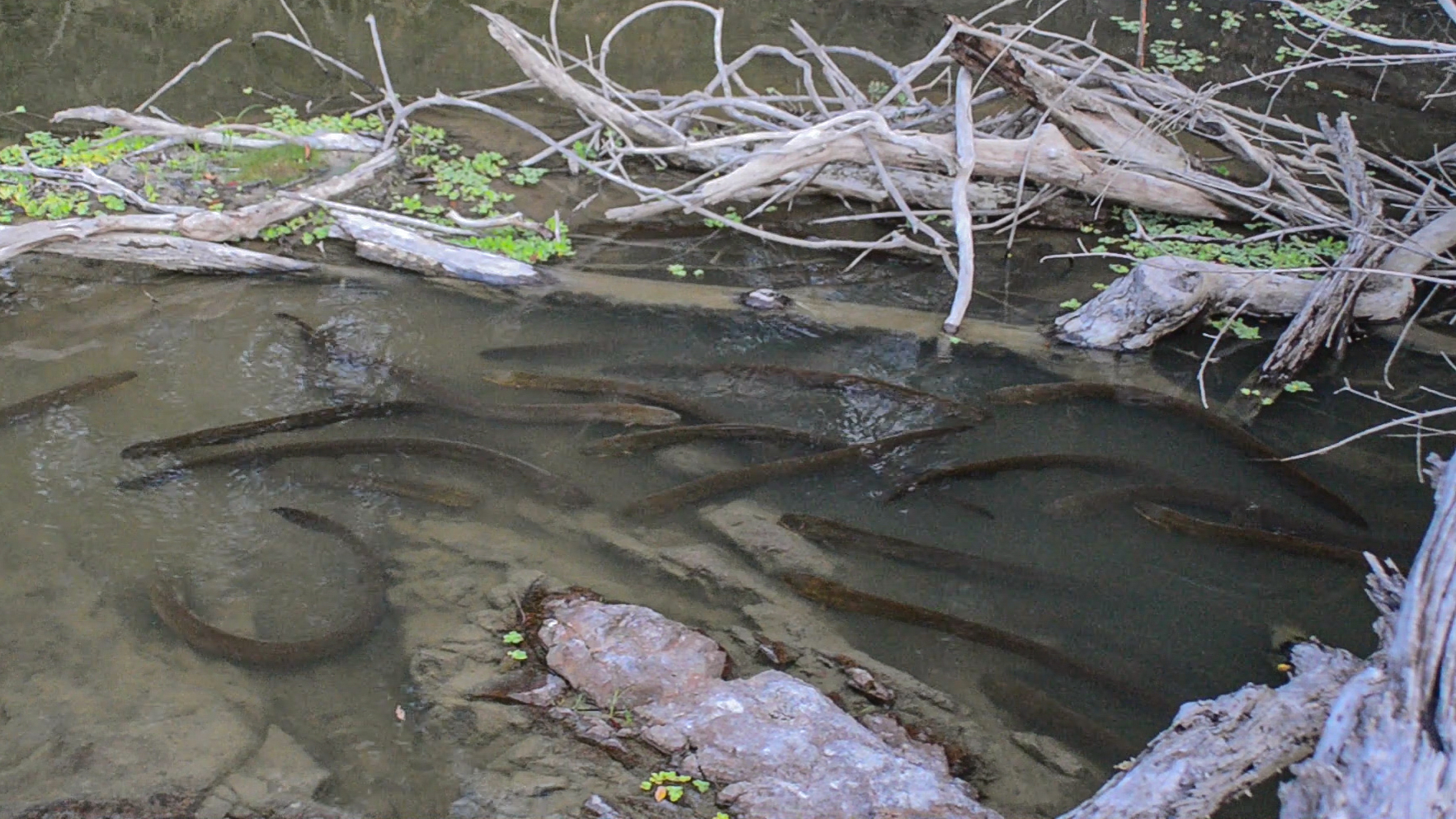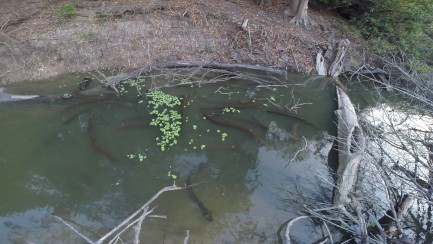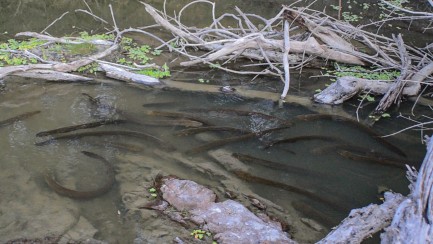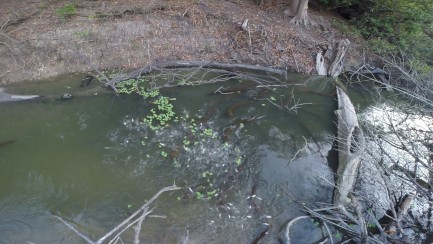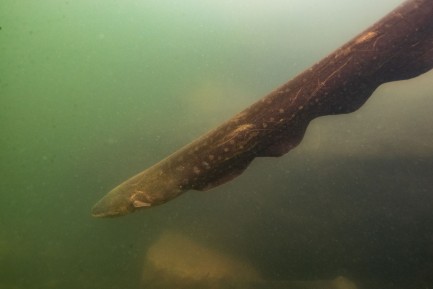An animated video abstract describing newly discovered group-hunting behavior found in electric eels.
Scientists Discover Electric Eels Hunting in a Group
Deep in the Brazilian Amazon River basin, scientists led by the Smithsonian’s National Museum of Natural History fish research associate C. David de Santana discovered a small, river-fed lake filled with more than 100 adult electric eels, many of which were upwards of 4 feet long. On its own, this was an intriguing discovery, electric eels—a type of knifefish rather than true eels—were thought to be solitary creatures.
But in this lake along the banks of the Iriri River in Brazil’s state of Pará, the researchers witnessed the eels working together to herd small fish called tetras into tightly packed balls. Then groups of up to 10 eels periodically split off to form cooperative hunting parties, not unlike packs of wolves or pods of killer whales. Those smaller groups then surrounded the prey ball and launched simultaneous electric attacks, stunning the tetras into submission.
“This is an extraordinary discovery,” de Santana said. “Nothing like this has ever been documented in electric eels.”
De Santana is the senior author of a new paper describing this novel behavior in the Jan. 14 issue of the journal Ecology and Evolution. The findings overturn the idea that these serpentine fish are exclusively solitary predators and open the door to new questions about how these little-understood fish live.
“Hunting in groups is pretty common among mammals, but it’s actually quite rare in fishes,” de Santana said. “There are only nine other species of fishes known to do this, which makes this finding really special.”
This new paper is the latest in a string of revelations driven by de Santana’s investigations of the mysterious lives of South America’s electric fishes. His pioneering expeditions into the murky, remote waters of the Amazon and its many tributaries have brought to light 85 new species of electric fishes. Just last year, he tripled the number of known species of electric eels, which had stood at one for roughly 250 years.
One of the new species of electric eel presented in his 2019 paper, Volta’s electric eel (Electrophorus voltai), is capable of producing 860-volt electric shocks—the strongest electric discharge of any animal on Earth and 210 volts higher than the previous record. The freshly described Volta’s electric eel, which can reach lengths of 8 feet, is also the species behind the social hunting strategy at the center of de Santana’s new research.
“If you think about it, an individual of this species can produce a discharge of up to 860 volts—so in theory if 10 of them discharged at the same time, they could be producing up to 8,600 volts of electricity,” de Santana said. “That’s around the same voltage needed to power 100 light bulbs.”
Direct measurements of these simultaneous shocks are one of the things de Santana and his colleagues hope to collect on their next expedition to the remote waterways of the Amazon basin. Fortunately for de Santana, who has been shocked more than once by individual eels in the field, the shock only lasts about two-thousandths of a second, but it is enough to cause a painful muscle spasm that might knock a person off their feet.
De Santana’s team first witnessed Volta’s electric eel hunting in groups during a field expedition in August of 2012. Douglas Bastos, a then Master of Science candidate at Brazil’s Instituto Nacional de Pesquisas da Amazônia (INPA) and the paper’s first author, travelled five days by boat to explore the fish diversity of the Iriri River. Bastos, now a scientist at INPA, discovered a small lake directly connected with the Iriri River, and to his amazement, the lake held more than 100 adult electric eels.
A subsequent expedition in October 2014 found a similarly prodigious collection of Volta’s electric eels in the same locality, which allowed Bastos to document the behavior in greater detail and confirm that it was not just a one-time event. In all, the team logged 72 hours of continuous observation of the eels congregating in this location along the Iriri River.
For the majority of the day and the night, the eels lay almost motionless in the deeper end of the lake, only occasionally coming to the surface to breathe—electric eels get the vast majority of their oxygen from air, an adaptation in response to the low-oxygen waters they sometimes inhabit. But at dusk and dawn the congregation began to stir.
In these twilight hours, the eels started interacting with each other and then began swimming in a large circle. This churning circle of electric eels corralled thousands of the 1-to-2-inch tetras into tighter and tighter shoals. The researchers watched the group herding the concentrated tetras from the deeper end of the lake—around 12 feet deep—to shallow, 3-foot deep waters.
With the tetras trapped by the main group, de Santana says bands of two to 10 eels would separate, move in closer and then launch joint electric attacks on the prey ball. The electric shocks sent the tetras flying out of the water, but when they splashed down the small fish were stunned and motionless. Finally, the attacking eels and their compatriots easily picked off their defenseless prey. According to de Santana, each dawn or dusk hunting ritual took around one hour and contained between five to seven high-voltage attacks.
“This is the only location where this behavior has been observed, but right now we think the eels probably show up every year,” de Santana said. “Our initial hypothesis is that this is a relatively rare event that occurs only in places with lots of prey and enough shelter for large numbers of adult eels.”
In de Santana’s estimation, the team’s interviews with locals would have turned up tales of writhing pools filled with electric eels if these gatherings were common. “These animals can be 8 feet long and produce 860-volt electric shocks; if 100 of them being in one place was a common occurrence, I think we would have heard about it before now.”
But when the conditions are right, this hunting technique allows the eels to subdue huge quantities of prey that are normally too evasive to capture. Electric eels customarily feed alone at night by sneaking up on sleeping fish and jolting them into an easy-to-eat torpor.
De Santana and his team hope that their newly launched citizen scientist program called Projeto Poraquê may help locate more of these special aggregations of eels. The project, named for an Indigenous Brazilian word for electric eel, will allow users to report sightings and log observations.
Now, de Santana and his colleagues are in the early stages of organizing the next expedition to this unique location along the Iriri. They hope to collect additional tissue samples and mark individual eels with radio tags to understand possible kin relations and hierarchy within the group. De Santana will also aim to take direct measurements of the electrical discharges produced during group hunting to assess their maximum voltage and to determine whether the eels might also be using low-voltage shocks to communicate and orchestrate their efforts, similar to how some marine mammals such as whales and dolphins use sound to coordinate when hunting their prey.
Many of these measurements will be challenging to collect in the field, so de Santana has secured permits to collect eight to 10 adult eels and bring them to a special facility in Germany where he and his collaborators can conduct more controlled tests, which could later be replicated in the field. This would be the first time a group of adult Volta’s electric eels has been held in captivity together.
With the Amazon under threat from deforestation, fire and climate change, de Santana said there is a profound sense of urgency to accelerate biodiversity assessment in the region. “Electric eels aren’t in immediate danger, but their habitats and ecosystems are under immense pressure. This paper is an example of how much we still don’t know, how many organisms whose life histories we don’t yet understand.”
Funding and support for this research were provided by the Smithsonian, the Global Genome Initiative, the Brazilian National Council for Scientific and Technological Development, the São Paulo Research Foundation and National Geographic.
# # #
SI-1-2021
Ryan Lavery
202-633-0826
Randall Kremer
202-360-8770
Note to editors: Multimedia, including videos and photos of electric eels hunting, can be found via Dropbox here (password: eels).

